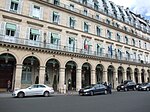Couvent des Feuillants

The royal monastery of Saint-Bernard, better known as the Couvent des Feuillants or Les Feuillants Convent, was a Feuillant nunnery or convent in Paris, behind what is now numbers 229—235 rue Saint-Honoré, near its corner with rue de Castiglione. It was founded in 1587 by Henry III of France. Its church was completed in 1608 and dedicated to Saint Bernard of Clairvaux. The nunnery was secularised and nationalised in the decrees of 13 and 16 May 1790 and became notable as the meeting place of the Feuillant Club. Jacques-Louis David used the nave of the convent's church as a studio for his painting The Tennis Court Oath. Most of the complex was then demolished under the French Consulate, leaving only the guesthouses at 229—235 rue Saint-Honoré (built in 1776 by Jacques Denis Antoine and classed as a historic monument in 1987) and the outline of its church's apse, which can be discerned in the courtyard of one of the guesthouses.
Excerpt from the Wikipedia article Couvent des Feuillants (License: CC BY-SA 3.0, Authors, Images).Couvent des Feuillants
Rue Saint-Honoré, Paris 1st Arrondissement (Paris)
Geographical coordinates (GPS) Address Phone number Website Nearby Places Show on map
Geographical coordinates (GPS)
| Latitude | Longitude |
|---|---|
| N 48.8662 ° | E 2.3291 ° |
Address
Maison Jean-Paul Hévin
Rue Saint-Honoré
75001 Paris, 1st Arrondissement (Paris)
Ile-de-France, France
Open on Google Maps










